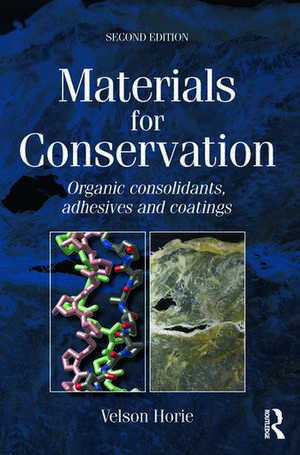Materials for Conservation
Autor C. V. Horieen Limba Engleză Paperback – 26 aug 2010
The first section explains physical and chemical properties which are important in the conservation process, i.e. application, ageing, reversal. The topics covered include molecular weight, glass transition temperature, solubility and solvents, polymerisation and degradation reactions. The second section provides a detailed consideration of the individual materials, current and obsolete, used in conservation, drawing out the factors relevant to their effects on objects. The conservation uses of each material are summarised and referenced to allow further study. In five appendices, the properties of the polymers, solvents and their interactions are tabulated, with a list of suppliers and conversion table of physical units. IUPAC and SI nomenclature is used throughout the book.
In this second edition, this classic text is revised and updated to include modern materials such as cyclododecane, and current ideas on adhesion, consolidation and reversibility, making Materials in Conservation the definitive source of vital information in the field.
This handy reference book should be on the bench of every conservator and available wherever objects, from steam engines to dried plants, are preserved.
| Toate formatele și edițiile | Preț | Express |
|---|---|---|
| Paperback (2) | 298.92 lei 5-7 săpt. | +37.32 lei 10-14 zile |
| Taylor & Francis – 26 aug 2010 | 699.49 lei 3-5 săpt. | +37.32 lei 10-14 zile |
| Elsevier Science – 23 sep 1987 | 298.92 lei 5-7 săpt. | |
| Hardback (1) | 1012.89 lei 6-8 săpt. | |
| Taylor & Francis – 10 sep 2015 | 1012.89 lei 6-8 săpt. |
Preț: 699.49 lei
Preț vechi: 768.67 lei
-9% Nou
Puncte Express: 1049
Preț estimativ în valută:
133.84€ • 140.12$ • 110.75£
133.84€ • 140.12$ • 110.75£
Carte disponibilă
Livrare economică 15-29 martie
Livrare express 04-08 martie pentru 47.31 lei
Preluare comenzi: 021 569.72.76
Specificații
ISBN-13: 9780750669054
ISBN-10: 0750669055
Pagini: 504
Ilustrații: 1, black & white illustrations
Dimensiuni: 152 x 229 x 34 mm
Greutate: 0.67 kg
Ediția:2nd edition
Editura: Taylor & Francis
Colecția Routledge
Locul publicării:Oxford, United Kingdom
ISBN-10: 0750669055
Pagini: 504
Ilustrații: 1, black & white illustrations
Dimensiuni: 152 x 229 x 34 mm
Greutate: 0.67 kg
Ediția:2nd edition
Editura: Taylor & Francis
Colecția Routledge
Locul publicării:Oxford, United Kingdom
Cuprins
PART I: BACKGROUND INFORMATION;
Introduction; Polymer science; Solvents; Adhesion; Uses and requirements of applied polymers-a summary;
PART II: SURVEY OF INDIVIDUAL POLYMERS;
Hydrocarbons; Vinyl acetate derived polymers; Acrylic resins; Miscellaneous synthetic thermoplastics; Polymers derived from cellulose; Natural water-soluble polymers; Natural resins; Cross-linking polymers; Fillers and colourants;
APPENDICES:
Polymer properties; Solvent properties, Polymer solution charts; Health and safety labelling, glossary.
Introduction; Polymer science; Solvents; Adhesion; Uses and requirements of applied polymers-a summary;
PART II: SURVEY OF INDIVIDUAL POLYMERS;
Hydrocarbons; Vinyl acetate derived polymers; Acrylic resins; Miscellaneous synthetic thermoplastics; Polymers derived from cellulose; Natural water-soluble polymers; Natural resins; Cross-linking polymers; Fillers and colourants;
APPENDICES:
Polymer properties; Solvent properties, Polymer solution charts; Health and safety labelling, glossary.
Descriere
Materials in Conservation is the definitive introduction to the properties of materials used in conservation. The continual struggle of conservators to ameliorate the deterioration of objects has led to increasing use of synthetic polymers. These materials are part of the sophisticated technology that has been developed to augment and often replace traditional materials and methods. Conservators therefore have a wider range of techniques available. However, they must be able to appreciate the potentials and pitfalls of any proposed technique.
The first section explains physical and chemical properties which are important in the conservation process, i.e. application, ageing, reversal. The topics covered include molecular weight, glass transition temperature, solubility and solvents, polymerisation and degradation reactions. The second section provides a detailed consideration of the individual materials, current and obsolete, used in conservation, drawing out the factors relevant to their effects on objects. The conservation uses of each material are summarised and referenced to allow further study. In five appendices, the properties of the polymers, solvents and their interactions are tabulated, with a list of suppliers and conversion table of physical units. IUPAC and SI nomenclature is used throughout the book.
In this second edition, this classic text is revised and updated to include modern materials such as cyclododecane, and current ideas on adhesion, consolidation and reversibility, making Materials in Conservation the definitive source of vital information in the field.
This handy reference book should be on the bench of every conservator and available wherever objects, from steam engines to dried plants, are preserved.
The first section explains physical and chemical properties which are important in the conservation process, i.e. application, ageing, reversal. The topics covered include molecular weight, glass transition temperature, solubility and solvents, polymerisation and degradation reactions. The second section provides a detailed consideration of the individual materials, current and obsolete, used in conservation, drawing out the factors relevant to their effects on objects. The conservation uses of each material are summarised and referenced to allow further study. In five appendices, the properties of the polymers, solvents and their interactions are tabulated, with a list of suppliers and conversion table of physical units. IUPAC and SI nomenclature is used throughout the book.
In this second edition, this classic text is revised and updated to include modern materials such as cyclododecane, and current ideas on adhesion, consolidation and reversibility, making Materials in Conservation the definitive source of vital information in the field.
This handy reference book should be on the bench of every conservator and available wherever objects, from steam engines to dried plants, are preserved.





















